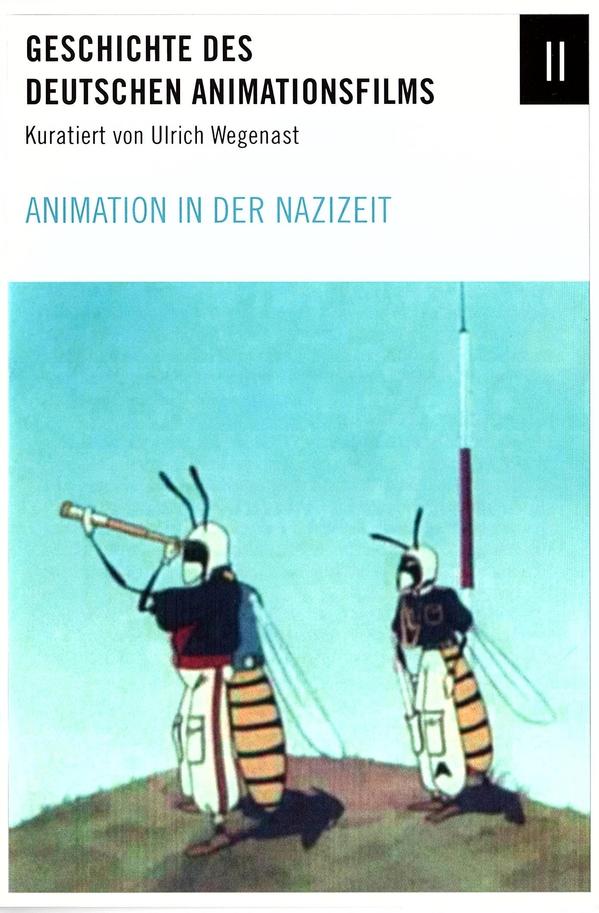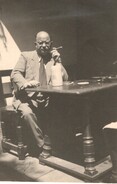- Home
- POSTER GALLERY
- ❗️BOOK & POSTER STORE❗️
- About the Posters
- The William Gillespie Collection
- Our Publishing House
- ❗️GFDN interviews author and collector William Gillespie ❗️
- Our most expensive & inexpensive finds!
- ❗️***NEW!*** Poster of the Month ❗️
- ❗️NEW ❗️Film Posters – Demands on an important means of film advertising. ❗️
- In our Book + Zeitschrift Library
- ❗️ ***NEW!*** Hitler Youth Quex – A Guide for the English–speaking Reader ***NEW!*** ❗️
- ❗️***NEW!*** Table of Contents of our new HJ QUEX book❗️
- ❗️Hitler Youth Quex Guide - early praise! ❗️
- Recent loans from the Collection
- Farewell Horst Claus. (1940–2024 †)
- "Der Deutsche Film" Zeitschrift
- ❗️ ***NEW!***German "Tendency" Films (Tendenzfilme) in the Third Reich ❗️
- KARL RITTER
- Karl Ritter original film posers in this Collection
- "Besatzung Dora" ( † 1943)
- "The Making of The Crew of the Dora"
- Karl Ritter at the 1938 Reichsfilmkammer Congress
- INDEX -"Karl Ritter" book, 2nd edition
- Karl Ritter's Legion Condor (1939, unfinished)
- Excerpt from our "Dora" book
- ∆∆∆∆∆ High praise for our DORA book! ∆∆∆∆∆
- TABLE OF CONTENTS – "Legion Condor"
- § § § § § Early Praise for our LEGION CONDOR book! § § § § §
- ❗️"Das Leben geht weiter" and Karl Ritter ❗️
- Zarah Leander Europe–wide !
- Japan Military Film and Karl Ritter
- Karl Ritter after 1945
- 1935 Film Congress
- Poster Exhibition in Berlin, March 1939
- Potsdam poster exhibition 12 April–25 August 2019
- Leni Riefenstahl's two "Olympia" Films (1938)
- "Ohm Krüger" (1941)
- Emil Jannings
- "Blutendes Deutschland" (1933)
- Hannes Stelzer ( † 1944)
- Klaus Detlef Sierck ( † 1944)
- Film stills
- Reich Film Censorship Offices
- ❗️Dateline: Ufa - April 11, 1945 ❗️
- ❗️***NEW!***The Fate of the German Film Industry in May 1945 ❗️
- Film censorship cards
- Film Archives
- Cinema advertising
- School filmstrips
- ❗️UPDATED❗️ Z F O / Ostland Film G-m-b-H
- Z F O / Herbert Jacobi estate
- ZFO / Ostland Film newspaper articles
- ❗️***NEW!*** Roter Nebel / Red Fog / Red Mist (1942/1943, ZFO) ❗️
- ZFO - Der Rückkehrer - The Returnee (1943/1944)
- The D F G production company
- D I F U
- ❗️ ***NEW!*** "Carl Peters" – Special Collection. ❗️
- "Alcazar" (1940, Genina)
- "Der 5. Juni" (1943, banned)
- ❗️ ***NEW!*** Herbert Selpin and his "Titanic" (1943) ❗️
- ❗️ ***NEW!*** Ein Robinson (1940, Fanck) ❗️
- "Fronttheater" (1942)
- Veit Harlan's Jud Süß and Fritz Hippler's Der Ewige Jude
- Harlan "Jud Süß" trial 1949
- Werner Krauss & JUD SÜß
- Anti-Semitic Film Posters in the Collection
- "Heimkehr" (1941)
- "Hitlerjunge Quex" (1933)
- ❗️***NEW!*** Hitlerjunge Quex in 111 Greater Berlin Cinemas ❗️
- Jürgen Ohlsen
- "S.A.Mann Brand" (1933)
- "In der roten Hölle" (Edgar Neville, 1939)
- "Helden in Spanien" (1938)
- The Spanish Civil War in Film
- Andrews Engelmann (1901 – 1992)
- Deutsche Wochenschau
- Uƒa Feldpost
- Uƒa Kulturfilm – Informationen
- " Die Tochter des Samurai" (1937, Fanck)
- Ufa 25th Anniversary
- Invitations to world premieres
- ❗️***NEW!*** Continental Films, Paris 1940–1944 ❗️
- Film Censorship in Occupied Paris 1942
- "Der Sieg des Glaubens" (1933)
- Wilhelm Althaus Estate
- Weimar Germany posters
- Ufa and the Ordensburgen
- The Gaufilmstelle in our Collection
- "Zwei Welten" (1940)
- "Capriccio" (1938) –Karl Ritter film album
- Unrealised NS Propaganda Films 1934–1945
- German Film Directors accused of "war crimes"
- Australian––themed NS feature films
- "Der Störenfried" / "The Troublemaker"
- What was new in 2014?
- What was new in 2015?
- What was new in 2016?
- What was new in 2017?
- What was new in 2018?
- What was new in 2019?
- What was new in 2020?
- What was new in 2021?
- What was new in 2022?
- What was new in 2023 ?
- What's new in 2024?
- ❗️***NEW!*** Hitler assassination attempt in Karl Ritter film cut❗️
- BESATZUNG DORA private photos
- Just discovered 1942 article on BESATZUNG DORA
- The Karl Ritter Tetralogy
- Google Analytics 2023
- Our first–ever acquisition!
- ❤️"Some of our favourite things....!"❤️
- ERRATUM for our " Hitler Youth Quex Guide"
- Trending
- Vale †
- Our Wants List / 2024 / Wunschliste
- Pop Quiz
- Unsere KARL RITTER Bücher in Deutschland liefbar!
- WHERE to buy our books right now?
- ✉️Contact
 “History is not about the facts. It is about the context and who is telling the story.” —Prof. Milton Fine.
“History is not about the facts. It is about the context and who is telling the story.” —Prof. Milton Fine.
"Who controls the past controls the future: who controls the present controls the past." –– George Orwell in his novel "1984."
"Whoever doubts the exclusive guilt of Germany for the Second World War destroys the foundation of post–war politics." –– Prof. Theodor Eschenberg, Rector, the University of Tübingen.
"If we have our own why in life, we shall get along with almost any how." – Friedrich Nietzsche
POSTER GALLERY --view
over 500 German film
original posters between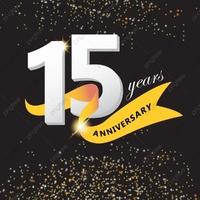
1927–1954 from
Germany and from
many Axis and Neutral countries
across Europe!
Note! Posters in the Poster Gallery are PERMANENT
acquisitions which are NOT FOR SALE!! ONLY the
posters listed in our POSTER STORE are for sale.
(They have a price and order button to use.)
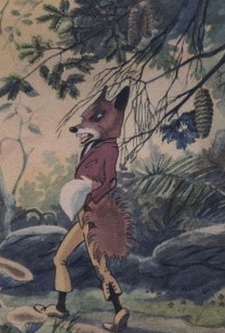
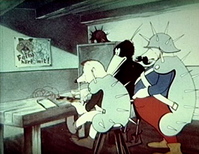
Der Störenfried / The Troublemaker (1940)
colour propaganda cartoon
The Collection in 2015 acquired twenty–five original B&W Bavaria Filmkunst press photos of the Hans Held 1940 colour cartoon, Der Störenfried (The Troublemaker); all with mimeographed original photo captions on the verso. The captions are individually numbered and it is clear that the original set had 28 photos. We are missing photographs #4, #9, and #23 from the set.
Synopsis (edited from from Wikipedia and other public sources)
A fox is on the loose! The forest animals awaken. A magpie sees that a fox is sneaking around in the forest and alarms the police bird and the rabbit father. The warning comes too late for three rabbit siblings: the fox grabs the girl rabbit and takes it to his burrow. The two rabbit brothers tell a hedgehog what has happened. He is already wearing his spiked uniform and is gathering his men to fight with the fox. He also asks the wasp squadron from the Wasenhorst Bullenwiese (Wasp Airfield, Bull Meadow) to help the hedgehogs fight the fox, and the wasps take off.
The fox, meanwhile, begins to heat a kettle for the girl rabbit. With the help of the other forest animals, including the rabbit father, the hedgehogs are gradually catapulted to the burrow and soon nail the fox to a tree with their spiky uniforms. Nevertheless, the fox frees itself and dashes around in the forest. Now the wasps attack the fox by swooping down like Stukas and sting him mercilessly.
Even that doesn't stop the fox from going back to its burrow. A rabbit throws eggs at the fox. When the egg-laying chicken wants to hatch its eggs in a hurry directly on the catapult, the fox wants to attack it and is hit by the stone falling on the catapult. Then the forest animals dance wildly.
Hans Held (1914 – 1995) originally drew advertising cartoons and advertising labels. During the war, he headed the cartoon department of Bavaria Filmkunst, which besides The Troublemaker only made apolitical entertainment films, including The Adventures of Baron von Munchausen - A Winter Journey.
The film has clear militaristic tendencies: the hedgehogs wear spiked uniforms and Wehrmacht helmets, while the wasps make shrill Stuka noises while flying and they attack the fox in combat aircraft formation. The fox is reddish brown in the colour film, and therefore in some post–war commentary is considered as a stand–in for the Red Army. The fable of all the forest animals banding together and fighting a common foe reinforced the Volksgemeinschaft ideology of National Socialism. The cartoon was aimed of course at children. Hitler Youth members would have seen a poster in these years proclaiming “Throw all troublemakers out!”
In her book Jugend in Film published by the Amtliches Organ des Jugendführers des Deutschen Reiches, Berlin; Anneleise Sander wrote her evaluation of the film:
"All in all, an original fantasy that reflects an experience close to the target. In this form, existing and newly invented animal fables could be wonderfully evaluated in a journalistic way, for children, young people and adults. I would like to assert that they will have the strongest effect on adults even when they have passed their acid test even from children; for children are incorruptible judges and are least likely to be deceived by superficial expedient maneuvers. Only if the film shown is designed with heart, only if it succeeds in convincing, can it be addressed as an effective hit. Only success decides." -- S. 37
The music for the cartoon was composed by Leo Leux, shown at LEFT, who also did the music for the important NS propaganda feature film Venus vor Gericht, Robert & Bertram, and the Hannes Stelzer Variété film Truxa, amongst others.
Here are some press photos from the film, which are presented in sequence to reflect the plot line:
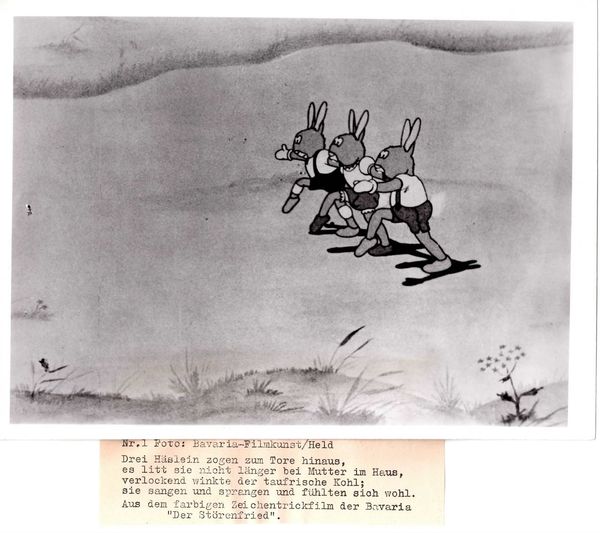
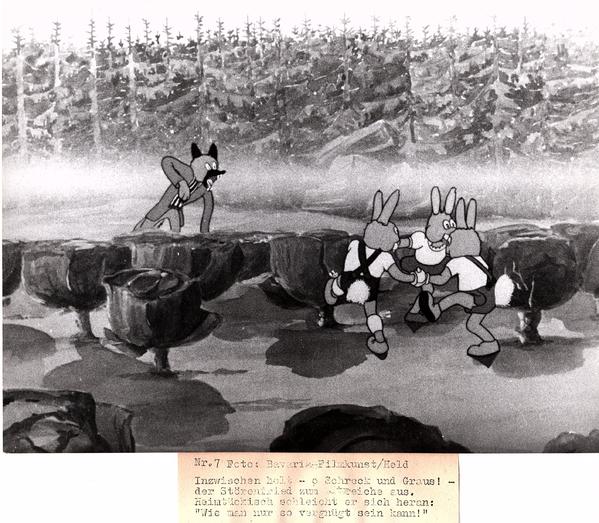
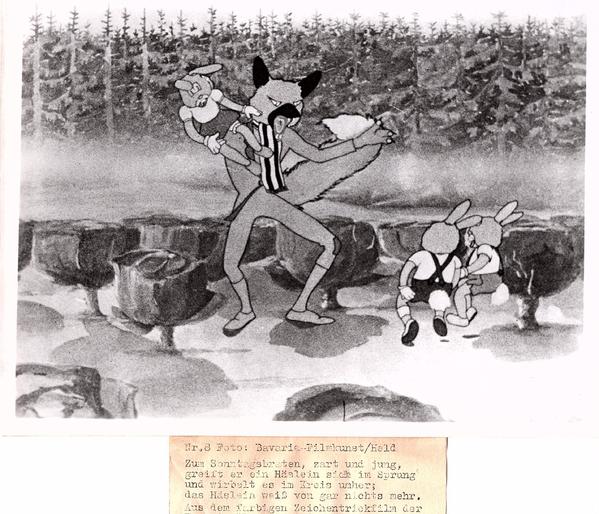
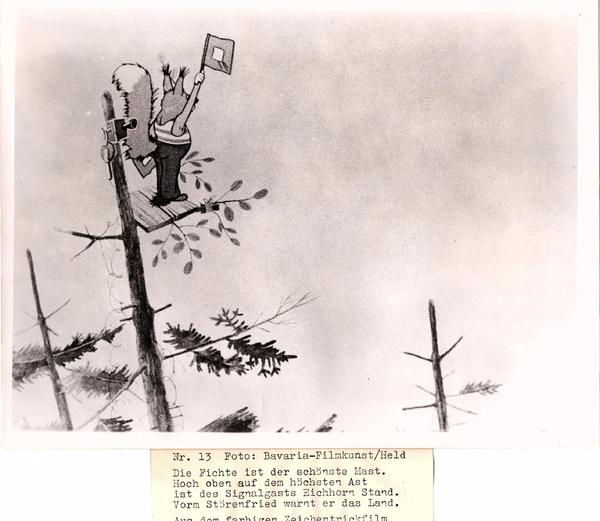
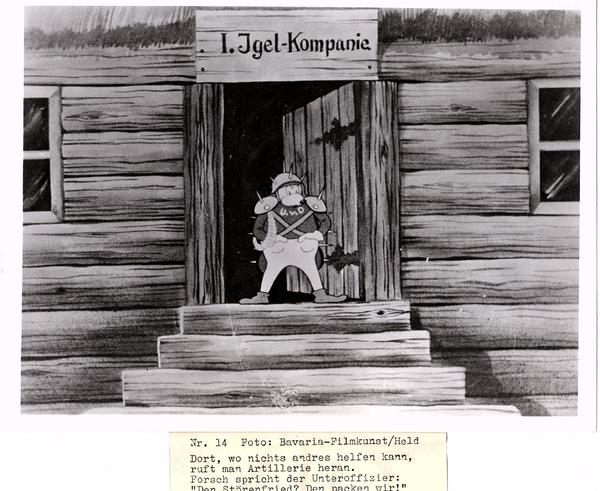
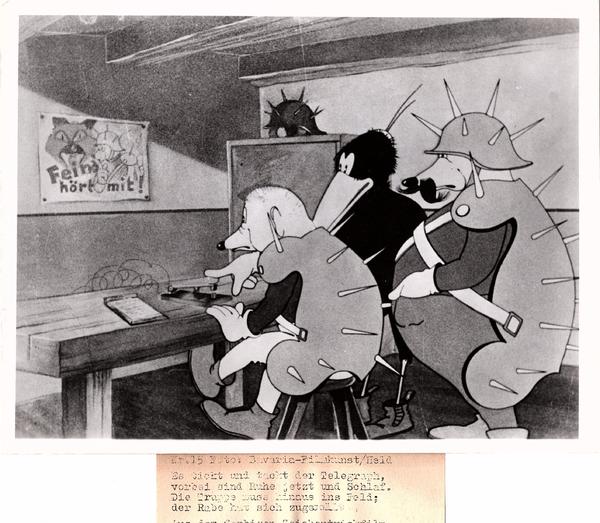
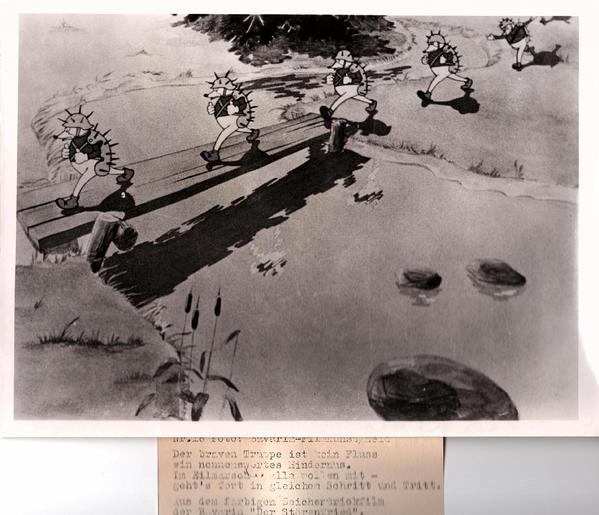
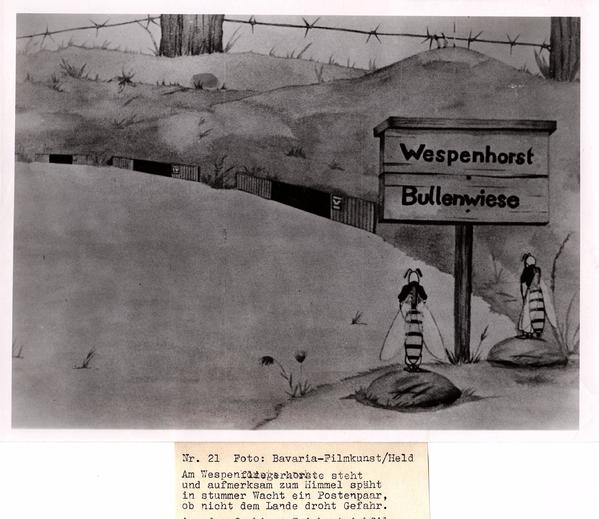
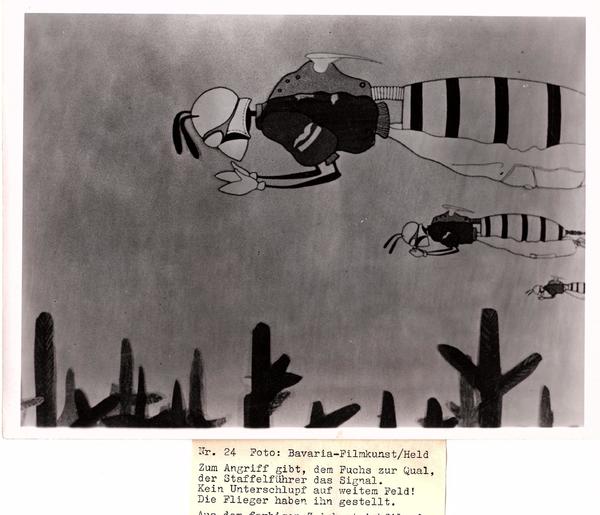
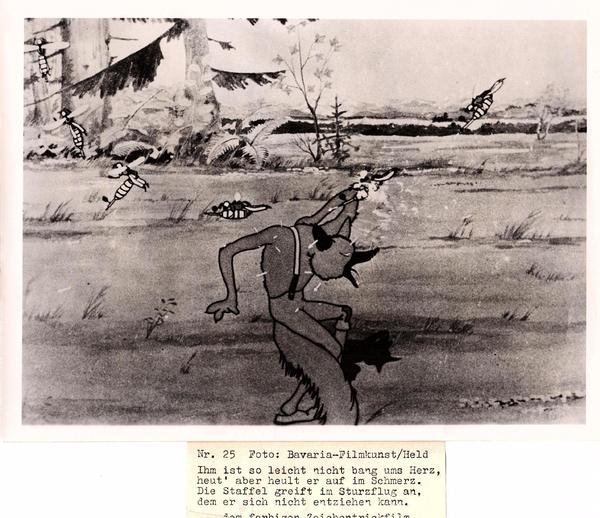
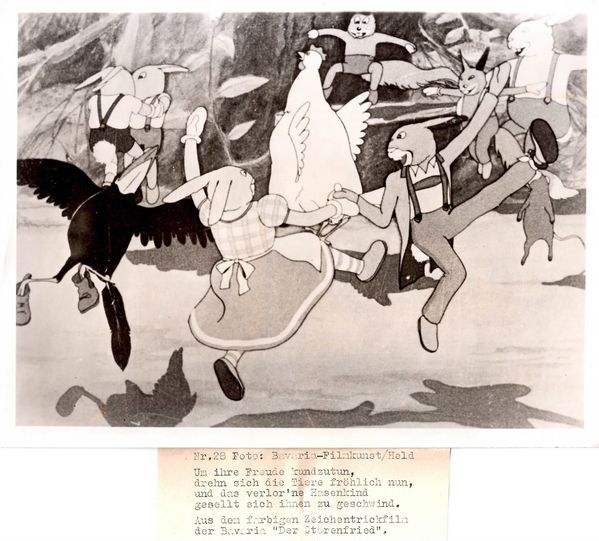
[ note: All B&W scans above are © 2020 by German Films Dot Net and are not to be reproduced without written permission.]
Der Störenfried cartoon is available on a DVD produced by Absolute Medien and sold on Amazon and on ebay.de (German language soundtracks only, no subtitles.) Here the cover of the DVD's booklet with a scene from the cartoon in colour:
